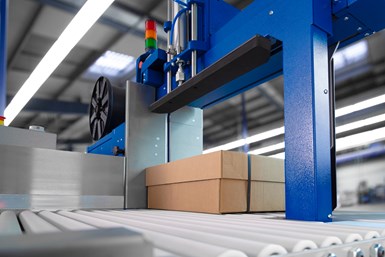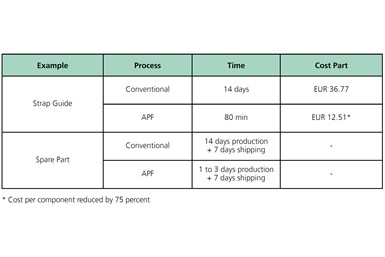Polymer AM Cuts Costs of Small-Batch Replacement Components
Producing replacement parts through polymer AM has cut Mosca’s lead times and component costs to small fractions of their original size, even when producing small batches of parts.
Share

With over 100,000 strapping machines installed worldwide and over 2,000 components in every machine, Mosca ran into trouble developing replacement parts before it turned to additive manufacturing. Photo Credit: Arburg
Mosca, an international manufacturer of end-of-line packaging solutions, prides itself on efficiency, reliability and a customer-oriented outlook. “We have installed more than 100,000 strapping machines worldwide,” says Stefan Kessler, innovation and technology manager at Mosca’s German headquarters in Waldbrunn.
But all machines require replacements for components at some point in their lives, and with over 2,000 individual components in each Mosca machine, the manufacturer found itself hard-pressed to build an inexpensive supply of replacement parts. Reprogramming and repurposing its CNC machines to produce these parts would be inefficient for the cost and make them unavailable for their main functions. Outsourcing production through traditional methods would also prove expensive — so Kessler began to consider whether additive manufacturing could provide a viable solution for replacement parts.
Settling on Freeforming
“First, we identified over 100 different components or spare parts that were too costly to manufacture using conventional methods,” Kessler says. “Then it was a matter of finding out which 3D printer could additively manufacture these parts in a way that would meet our strength requirements.”

The PA10 (nylon 10) material the Arburg Freeformer uses meets Mosca’s strength, speed and dimensional stability requirements, maintaining the same quality as the aluminum and plastics the company had previously used. Photo Credit: Arburg
This search led Mosca to Arburg’s Freeformer system. The Arburg plastic freeforming (APF) method processes standard plastic granulates, which the company says is suitable for both prototyping and industrial additive manufacturing of functional components.
Arburg's Freeformer system met Mosca’s requirements for strength, dimensional stability and speed, and the elimination of traditional tooling made small-batch production feasible.
Reduced storage requirements and potential for unmanned production further enhanced the Freeformer’s value-add to the manufacturer. The partnership enabled Mosca to additively manufacture parts overnight and ship them to customers immediately, rather than wait through lengthy lead times.
Cost and Inventory Efficiency Through Digital Warehousing
“We print all the time,” Kessler says. “Depending on the size and geometry, the production time for a component can be less than three hours. For example, a strap guide can be additively manufactured in 80 minutes and costs, in this case, can be reduced by 75%. The ability to produce complex, lighter components significantly helps reduce our energy and transport costs.”
Programming times on CNC systems are no longer a bottleneck, and on-demand additive manufacturing has eased Mosca’s fears of over- and under-utilization of machines. The move towards digital warehousing increases efficiency and further eliminates bottlenecks for the production team.

Changing its replacement part production to additive manufacturing methods has enabled Mosca to shave weeks off delivery times while significantly reducing costs. Photo Credit: Arburg
Even with the concerns over economic utilization that typically surround AM systems, production has proved less expensive than with conventional manufacturing. Part of this is down to materials: the PA10 (nylon 10) feedstock Mosca is using has proved inexpensive compared to the aluminum or POM or PE plastics the manufacturer previously needed, even while maintaining the same quality levels.
The Future of AM at Mosca
The Freeformer has been in operation since October 2019. Mosca predominantly uses the Freeformer for production parts (around 75% of its capacity), with the rest of its use focused on prototyping, product development and innovation — enabling Kessler and the rest of the process team to explore the design freedom and diverse possibilities of the APF process. “We see great technological potential for the Freeformer when it comes to qualifying more materials and combining different materials,” he says. “We want to make two-component-parts, too.”
Related Content
DMG MORI: Build Plate “Pucks” Cut Postprocessing Time by 80%
For spinal implants and other small 3D printed parts made through laser powder bed fusion, separate clampable units resting within the build plate provide for easy transfer to a CNC lathe.
Read MoreMultimaterial 3D Printing Enables Solid State Batteries
By combining different 3D printing processes and materials in a single layer, Sakuu’s Kavian platform can produce batteries for electric vehicles and other applications with twice the energy density and greater safety than traditional lithium-ion solutions.
Read MoreHow to Build 10,000+ Shot Molds in Hours
Rapid tooling isn’t so rapid when it takes days to 3D print a metal mold, and then you still must machine it to reach the necessary tolerances. With Nexa3D’s polymer process you can print a mold in hours that is prototype or production ready and can last for more than 10,000 shots.
Read MoreLarge-Format “Cold” 3D Printing With Polypropylene and Polyethylene
Israeli startup Largix has developed a production solution that can 3D print PP and PE without melting them. Its first test? Custom tanks for chemical storage.
Read MoreRead Next
4 Ways the Education and Training Challenge Is Different for Additive Manufacturing
The advance of additive manufacturing means we need more professionals educated in AM technology.
Read MoreAt General Atomics, Do Unmanned Aerial Systems Reveal the Future of Aircraft Manufacturing?
The maker of the Predator and SkyGuardian remote aircraft can implement additive manufacturing more rapidly and widely than the makers of other types of planes. The role of 3D printing in current and future UAS components hints at how far AM can go to save cost and time in aircraft production and design.
Read More3D Printing Brings Sustainability, Accessibility to Glass Manufacturing
Australian startup Maple Glass Printing has developed a process for extruding glass into artwork, lab implements and architectural elements. Along the way, the company has also found more efficient ways of recycling this material.
Read More









.png;maxWidth=300;quality=90)













